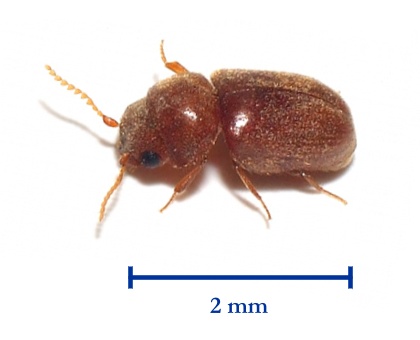SERVICE REQUEST?
Fill out the form below.
Find our nearest location
Your Local Office

Cigarette Beetle
Attribution: Kamrank, [GFDL or CC-BY-SA-3.0], via Wikimedia Commons
Size:
About 1/10 of an inch
Color:
Shiny brown
Behavior:
The female cigarette beetle lays 30-40 eggs over a period of weeks in a stored tobacco or dried food product. The eggs hatch within six to 10 days and the larvae begin crawling throughout the food source while feeding. The larvae prefer the dark and take about 5 to 10 weeks before pupating. The entire life cycle takes up to 90 days to complete with up to six overlapping generations occurring each year in warm climates. This shorter life cycle permits a faster development of cigarette beetle populations, facilitating the spread of cigarette beetles to uninfested food products stored nearby. This beetle is an external feeder, meaning the larvae develop outside of whole seeds. It is most commonly associated with processed foods of all kinds. Adult beetles are strong fliers most commonly seen in low light conditions. This beetle can be found throughout the year, but is especially common during the fall and winter.
As its name implies, the cigarette beetle is a pest of dried tobacco in tobacco warehouses and processing facilities. Interestingly, this beetle is not commonly found infesting stored cigarettes or cigars in stores or homes. It will infest a wide variety of food products and is common in pet food, cereals, nuts, dried peppers, spices, raisins, seeds and dried straw flours. Cigarette beetle larvae have also been found to feed on the stuffing inside upholstered furniture. The cigarette beetle is also a major pest in museums, where it attacks botany displays and other artifacts of vegetative origin.
The control of any stored product pest involves many steps, primary of which is discovery of infested food items or other sources of infestation (e.g., food spillage accumulation). All dried food products need to be inspected for signs of infestation, including cereals, packaged dried foods (e.g., food bars and chocolate) and pet foods. Cigarette beetles have also been found infesting dried flowers, potpourri and dried peppers used as decorations. Keep in mind that infested items may not always be stored in the kitchen. Spices, potpourri and decorations made of vegetative products may be stored in any room of a house. Infestations have also been traced to caches of nuts and seeds accumulated by squirrels or rodents within attics, walls and chimneys. A pest management professional can be helpful in finding difficult infestation sources. Also consider the following to prevent an infestation: · Discard infested foods in outdoor trash. Infested decorations (flowers, wreaths, etc.) should also be discarded. · Freeze suspect foods at zero degrees Fahrenheit for six days. · Clean cabinets and shelves where infested foods are stored by vacuuming and by using soap and water. · Store all dried food goods, including dried pet foods and birdseed, in a glass or plastic container with a tight lid. If beetles are in that food product then the infestation will be contained and not spread to other foods. · Consider storing cereals and similar foods in the refrigerator to limit stored product pest problems. · Consume older food products prior to newer purchases of the same food. Products purchased in larger quantities (e.g., from a wholesale food warehouse) are more likely to become an infestation source if these are stored for long periods of time – especially if they are not stored in containers with tight-fitting lids.
Family Name:
Lasioderma serricorne
Read What Our Clients
Are Saying
My Terminix tech Scott is the best! He is professional, courteous and absolutely thorough about his job. Thank you for sending such a blessed tech to my house. Hamlet, NC
This letter is to say how pleased we are here at Morreene West Apartments with your services. We are very pleased with the technician, Christopher. He does a great job. Durham, NC
Terminix has consistently offered our apartment complex reliable, competent service. We are completely satisfied with their knowledgeable representative who is always punctual and does a superior job for us every time. Chapel Hill, NC
I would like to take the time to thank you for giving us such great service here at Carver Pond Apartments. Your Pest Technician Christopher Mitchell has provided us with excellent service over the last few months. Christopher is such a great help to us in providing helpful information so that we can better serve our residents here at Carver Pond. Durham, NC
SERVICE REQUEST?
Fill out the form below.